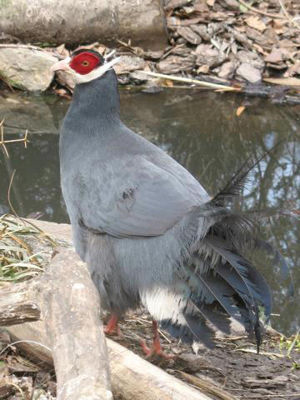Blue ear pheasant
| Blue ear pheasant | ||||||||||
|---|---|---|---|---|---|---|---|---|---|---|

Blue ear pheasant |
||||||||||
| Systematics | ||||||||||
|
||||||||||
| Scientific name | ||||||||||
| Crossoptilon auritum | ||||||||||
| ( Pallas , 1811) |
The blue ear pheasant ( Crossoptilon auritum ) is a monotypical bird species from the pheasant-like family . It is native to the mountains of western and central China and inhabits alpine shrubbery, mixed and juniper forests there .
description
Most of the body's plumage is blue-gray and looks worn like hair. The head is velvety black except for the nape of the neck, with a contrasting white chin, white cheek feathers and the greatly elongated, tufted white feather ears protruding over the nape, as well as the bare, intense red area around the eye. The iris is yellowish, the bill reddish horn-colored. The dark brown arm wings show a purple shimmer and the hand wings are dull brown. The tail consists of 24 dark blue-gray control feathers , which become darker towards the middle and have a metallic green, shimmering purple-violet towards the end. The flags are also tattered like hairs. The bases of the 5–6 outer control feathers show a wide white transverse band that forms a white mirror. On the distal part, these feathers shine in a dark steel blue. The feet are red.
The genders do not differ externally. The body length is 96 cm, the tail length 49 cm and the wing length between 290 and 306 mm. The rooster weighs between 1.7 and 2.1 kg, the hen is lighter at 1.5–1.75 kg.
voice
The rooster call for territory is a crowing weevil , while looking for food a chicken-like cuckoo cuck can be heard. The warning call is described as creaking.
distribution
The blue-eared pheasant can be found in the mountains of Inner Mongolia , Gansus and eastern Qinghai . To the south, the distribution extends to northwestern Sichuan . Subspecies are not described.
Way of life
The blue ear pheasant inhabits alpine shrubbery, mixed and juniper forests. The birds look for food in clearings such as clearcuts or burned areas and spend the night in the thick forest. The food consists of insects and subterranean plant parts. It is mainly searched for on the ground, the upper layer of which is first scratched up with the feet. Outside of the breeding season, the species lives gregariously in flocks that could be family groups. Couples get together in spring. The nest consists of a shallow, excavated hollow with a diameter of 25 to 27 cm, which is covered with moss, grass and leaves so that it can hardly be distinguished from its surroundings. In addition, springs are apparently used as padding. The clutches found consisted of 8–14 monochrome olive-brown eggs. The incubation period is between 26 and 28 days.
literature
- Heinz-Sigurd Raethel : Chicken birds of the world. Verlag J. Neumann-Neudamm GmbH & Co. KG, Melsungen 1988, ISBN 3-7888-0440-8 .
Web links
- Crossoptilon auritum in the Red List of Threatened Species of the IUCN 2009. Posted by: BirdLife International, 2009. Retrieved on 30 September, 2010.
- Videos, photos and sound recordings for Crossoptilon auritum in the Internet Bird Collection
- Photos of Crossoptilon auritum in the Oriental Bird Club image database , accessed on September 30, 2010